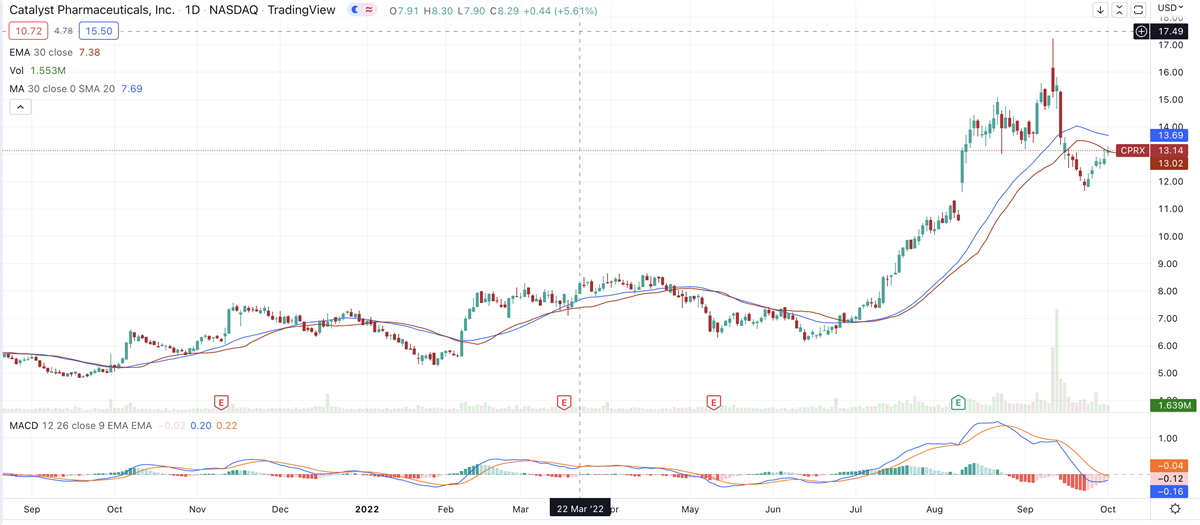 Small-cap biotech Catalyst Pharmaceuticals (NASDAQ: CPRX) has been outperforming the broader market, amid recent earnings and revenue acceleration.
Small-cap biotech Catalyst Pharmaceuticals (NASDAQ: CPRX) has been outperforming the broader market, amid recent earnings and revenue acceleration.The company also got some good news last month, as it joined the S&P 600 Small-Cap index, replacing defense contractor ManTech, which was acquired by private equity giant The Carlyle Group (NASDAQ: CG).
Joining a major index, such as the S&P 600, means funds tracking that index must purchase shares and maintain weightings roughly in line with the benchmark’s composition.
This means Catalyst, makes amifampridine, a medication for a rare autoimmune condition called Lambert-Eaton myasthenic syndrome. This affects the neuromuscular and neurological systems. This condition can be associated with lung cancer patients, but also occurs in those without cancer.
Catalyst has a market capitalization of $1.35 billion. The company went public in 2006, so is somewhat out of the 15-year post-IPO zone, when companies often notch their biggest price gains. However, the stock has posted significant increases recently:
- 1 week: +8.09%
- 1 month:-5.24%
- 3 month: +83.02%
- Year-to-date: +89.51%
- 1 year: +142.08%
Shares rallied to an all-time high of $17.22 on September 13, on news of the index inclusion. But as the small-cap index, along with the broader market fell, Catalyst got swept up in the downtrend.
Nonetheless, it’s instructive to compare the stock’s performance against its index. You can track the S&P 600 by a number of ETFs, such as the SPDR Portfolio S&P 600 Small Cap ETF (NYSEARCA: SPSM).
The index is down 24.71% year-to-date, and also in shorter rolling time frames. Small caps underperformed Monday as large caps posted solid rallies. Catalyst bucked that trend, with a gain of 2.42%, or $0.31, finishing the session at $13.14. Trading volume was below normal.
Here’s one thing to watch for with a small stock like this: If you look at a one-minute chart, you’ll see gaps between price movements. That’s because with 87.4 million shares in float, and with 14% of shares owned by management, there aren’t really too many buyers and sellers. Sometimes that means it can take a minute (literally) to find an agreement on a price.
Despite that potential drawback, which actually doesn’t affect retail investors much at all, the company has plenty of positives: Revenue growth accelerated in the past three quarters, from 23% to 46%.
Its three-year revenue growth rate is 36%.
The three-year earnings growth rate is 54%. Earnings growth also accelerated in the past three quarters, from 17% to 75%.
The company reports its third quarter on November 8, with analysts eyeing earnings of $0.19 per share on revenue of $53.35 million. Those would be increases of 36% and 48%, respectively.
MarketBeat earnings data show that Catalyst has a rocky history when it comes to beating or missing both top- and bottom-line views.
The company’s return on equity is a very strong 31%, an indication of good management.
Analyst ratings compiled by MarketBeat show that Catalyst has been designated a “moderate buy” with a price target of $14.81, a potential upside of 12.81%. That’s a more realistic buy zone, at the moment, rather than watching for the stock to zip past that prior high of $17.22, given the current market conditions.
As a whole, biotechs are among the market’s biggest winners right now, with companies such as Apellis Pharmaceuticals (NASDAQ: APLS), Aerie Pharmaceuticals (NASDAQ: AERI), Belite Bio (NASDAQ: BLTE), Verona Pharmaceuticals (NASDAQ: VRNA) and Revance Therapies (NASDAQ: RVNC) being some of the top price performers in the market right now, among all industries and sectors.
With the exception of Apellis, which is a mid-cap, all the others fall into the small-cap category, where you’ll often find stocks with outstanding price action. As noted earlier, a small market cap and small float can help a stock rise to the top without much institutional support, but always use caution, especially in the notoriously volatile biotech sector, where a disappointing clinical trial can send a stock plummeting. 





